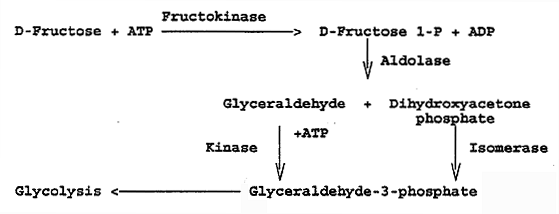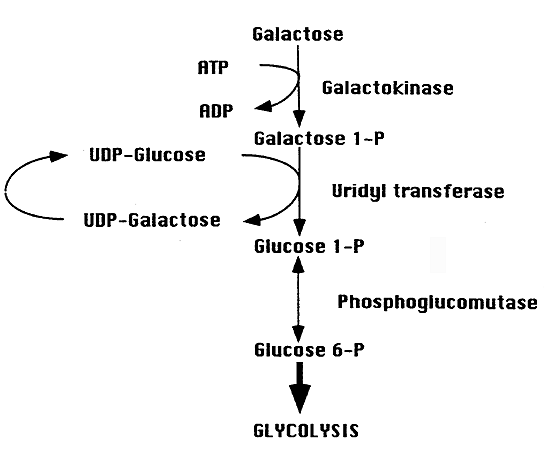
The Glycolysis Pathway:
Dehydrogenase (DH): "oxidation-reduction" reactions, look for NADH or FADH2
Kinase: "Substrate Level Phosphorylation"
Overall Pathway:
Glucose is metabolized to pyruvate.
All intermediates carry phosphate groups to lock them into the cell (stops diffusion).
Hexokinase / Glucokinase: both irreversible
Glucose + ATP ----> Glucose-6-phosphate + ADP
Hexokinase:
Catalyzes the phosphorylation of hexoses in general and is found in all cells that metabolize glucose.
Has a low Km (high affinity) so that it is active even at low glucose concentrations.
Glucokinase:
Glucose specific, found in liver.
Has a high Km (low affinity) to ensure a n appropriate response to elevation of glucose from the diet.
Phosphofructokinase-1 (PFK-1): irreversible
Fructose-6-phosphate + ATP ------> Fructose-1,6-bisphosphate + ADP
Rate-Limiting, Major Regulated Step.
Aldolase:
Fructose-1,6-bisphosphate <----> Dihydroxyacetone phosphate +Glycerladehyde-3-phosphate
Completes the first phase of glycolysis.
These trioses are interconverted by triose phosphate isomerase ------------>
To produce a single product, glyceraldehyde-3-phosphate.
Two molecules of glyceraldehyde-3-phosphate continue through glycolysis.
Glyceraldehyde-3-phosphate Dehydrogenase: Oxidation-Reduction
Glyceraldehyde-3-phosphate + NAD+ + Pi <---> 1,3-Bisphosphoglycerate + NADH
NADH formed must be reoxidized to regenerate NAD+ to sustain glycolysis.
Energy released from this reaction is conserved as a high energy phosphate bond in 1,3-bisphosphoglycerate.
Inorganic phosphate, rather than ATP, provides the source of the phosphoryl group.
Aerobic Conditions:
Mitochondrial systems oxidize NADH and produce ATP.
Phosphoglycerate Kinase: "Substrate Level Phosphorylation"
1,3-bisphosphoglycerate + ADP <----> 3-phosphoglycerate + ATP
1,3-Bisphosphoglycerate is a high energy intermediate that drives the phosphorylation of ADP to ATP.
Remember: Two molecules are proceeding through glycolysis, so 2 ATP.
Pyruvate Kinase: "Substrate Level Phosphorylation"
Phosphoenolpyruvate + ADP -------> Pyruvate + ATP
Irreversible, Highly Regulated.
Produce 2 ATP.
Lactate Dehydrogenase: "Anaerobic"
Pyruvate + NADH ----> Lactate + NAD+
This step regenerates NAD+ for glyceraldehyde-3-phosphate dehydrogenase or glycolysis would STOP.
H4: heart isozyme, high affinity for lactate (low Km), allosterically inhibited by pyruvate.
When pyruvate is high oxidizes to Acetyl CoA.
M4: muscle isozyme, produces lactate in muscle when pyruvate is high.
Energy Yield:
Anaerobic (i.e. RBC): Pyruvate ---> Lactate, 2 ATP per glucose molecule.
Aerobic: Mitochondrial oxidation of NADH via electron transfer shuttles.
NADH ----> 2 ATP, a-glycerol phosphate shuttle (4 ATP per glucose)
NADH ----> 3 ATP, malate-aspartate shuttle (6 ATP per glucose)
Fructose Metabolism:
Occurs in liver.

Galactose Metabolism:
Occurs in liver.

UDP-Glucose is an activated form of glucose found as an intermediate in glycogen formation.
UDP-Glucose is recycled from UDP-Galactose thus, there is no NET change in concentration of this compound.
Fructose and Galactose Energy Production: still 2 ATP.
(Fructose enters at glyceraldehyde-3-phosphate)
(Galactose enters at glucose-6-phosphate)
© Dr. Noel Sturm 2020